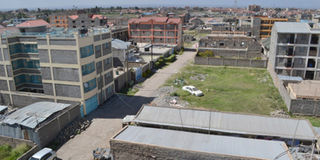Pension reforms absolutely essential, but can NSSF be trusted to do the job?

View of a section of the Tassia II Settlement Scheme. Police said about 10 men armed with pangas raided Mabatini Slum in Tassia, Nairobi, on October 12, 2014 night and attacked five men, leaving one dead, two seriously injured and the fifth with minor injuries. FILE PHOTO
What you need to know:
- The recent Tassia Project debacle does little to win public confidence and it, like many others before it, embodies the essence of what ails the NSSF.
- As pressure increases on disposable income, long-term saving seems like a luxury. Coupled with a culture of consumerism, the consequences are far-reaching.
When the National Social Security Fund Act received presidential assent on December 24, last year, Kenyans were oblivious to the implications of a fast approaching commencement date.
What ensued were frantic efforts by ill-prepared stakeholders to understand the Act and comply with it before the January 31 deadline.
Reprieve, however, came with the postponement of the commencement date to June 1. We can now take a step back to mull over the shape and fabric of the NSSF Act.
NSSF as an institution is riddled with a history of fiduciary mischief. Questionable investment decisions have resulted in losses running into billions of shillings, leading most Kenyans to wonder whether it can be trusted as the custodian of their contributions.
Unless this issue is addressed, all other items on the reform agenda will be purely academic.
The recent Tassia Project debacle does little to win public confidence and it, like many others before it, embodies the essence of what ails the NSSF.
The composition and appointment of the board of trustees under the new NSSF Act raises eyebrows. Previously, the board, a tripartite made up of Cotu, the Federation of Kenya Employers and the government, oversaw board decisions.
Under the new regime, the Cabinet Secretary for Labour yields absolute discretion in the appointment of trustees. The principal secretaries for Finance and Labour also sit on the board.
It is this board composition, dominated by the government, which raises questions about the ability of the NSSF to make prudent decisions free of influence from the Executive.
INCREASING BURDEN
History aside, old age poverty is a harsh reality, with only three per cent of workers retiring today being able to afford a decent pension. Clearly, efforts being made to save for retirement are bearing little fruit.
African Development Bank population data estimates indicate that life expectancy in East Africa will increase from 57 years in 2012 to 65 years in 2030 against a population growth rate that will decline to two per cent from 2.5 per cent in 2012, confirming a continuously shrinking workforce with an increasing burden of supporting the aged.
Breaking this perpetual cycle of old-age poverty has never been as urgent. As pressure increases on disposable income, long-term saving seems like a luxury.
Coupled with a culture of consumerism, the consequences are far-reaching. To break free from this cycle, radical changes must be made.
The Act is, therefore, a long overdue attempt to command meaningful levels of savings towards retirement provision.
Both employers and employees will now be required to increase pension contributions. Currently, the percentage of a worker’s pre-retirement income paid out by the NSSF upon retirement stands at approximately two per cent. The Act envisions raising this to 40 per cent.
Two tiers of contribution are also introduced. Tier I, payable to the NSSF, will be calculated at 12 per cent of an employee’s earnings up to the prevailing average minimum wage (Lower Earnings Limit or LEL). The current LEL stands at Sh6,000 a month.
All employees earning Sh6,000 and above will henceforth contribute Sh720 monthly up from the current Sh400.
Tier II contributions are payable either to the NSSF or to a private retirement fund approved by the Retirement Benefits Authority to receive them.
These will be deducted only from employees earning above the minimum wage and will be calculated at 12 per cent of the difference in earnings between LEL and the Upper Earnings Limit or UEL. The prevailing UEL stands at Sh18,000 per month.
The total mandatory contribution deductible is, therefore, the total of Tier I and Tier II contributions.
DOUBLE-EDGED SWORD
However, the deduction rate will be gradually implemented over four years so that the full 12 per cent will strictly apply as from 2018.
Interesting to watch will be the scramble for Tier II contributions between the NSSF and private retirement funds. Private funds have been required by the Retirement Benefits Act to adhere to the strict regulations of the RBA.
These include filing statutory returns of contributions, preparation and submission of investment policies, and filing financial statements.
Most private retirement funds are well-managed and will certainly dangle this as their main value proposition to woo contributors’ funds.
Although the NSSF is required to comply with the same regulations, enforcement has proven a Herculean task for the RBA. Thus, NSSF would do well to comply with the Retirement Benefits Act.
The Act is a double-edged sword. Higher contribution rates will raise the cost of doing business. However, if properly invested and managed, members stand a better chance of achieving a decent pension.
The increased inflows, estimated at approximately Sh17 billion in the first year will stimulate capital and money markets towards better returns and better investment opportunities.
Stakeholders thus have a moral and fiduciary duty to ensure contributions are managed efficiently and transparently.
Mr Mogere is an executive director, Clan Consulting Ltd. ([email protected])




